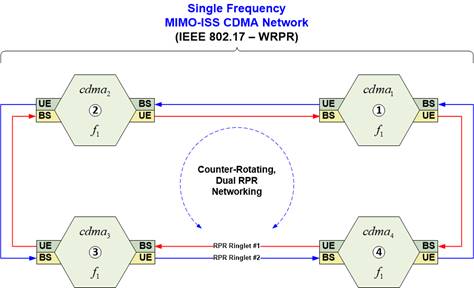Networking Architecture
The MIMO-CRN Networking System introduces three “innovative” networking concepts. These networking concepts are:
- Cellular Radar Networking
|
- Disruption Tolerant Networking
|
- Non-Linear CDMA Spread Spectrum Networking (i.e. Densification)
|
MIMO-CRN aims to realize a highly robust, bidirectional, and disruption-tolerant cellular communications network for “smart city” type applications. The network aims to be dynamic in nature, and to deliver multiple data flows with different priorities (operational voice, command/control, telemetry, various qualities of video flows, and others). MIMO-CRN aims to be bandwidth and power efficient. Quality of Service (QoS) algorithms in a Mobile Ad hoc NETwork (MANET) setting are provided to support an environment where autonomous vehicles, smart homes and infrastructure synergistically cooperate to create “smart” cities.
MIMO-CRN architecture and concepts offers significant advancements in the cellular system’s time and spatial synchronization architectures, waveforms, protocols, and algorithms. Most importantly, the architecture for this system is based on the cellular single-frequency networking (SFN) concepts.
MIMO-CRN is composed of four major network architecture subsystems. These network architecture subsystems are:
- Single-Frequency Network (SFN) Subsystem
|
- Delay Tolerant Network (DTN) Subsystem
|
- Wireless Token Ring Protocol (WTRP) Network Subsystem
|
- Wireless Resilient Packet Ring (WRPR) Network Subsystem
|
Figure 3 below illustrates the proposed the MIMO-CRN protocol hierarchy. MIMO-CRN proposes to integrate these networking protocols into a seamless, novel, and coherent 5G cellular network architecture.
MIMO-CRN Protocol Hierarchy Diagram |

|
Figure 3: MIMO-CRN enables Delay Tolerant, Mobile Ad-Hoc Network (MANET) Capability |
In addition to the core 5G IMT-2020 networking protocols, to achieve the robustness and resiliency objectives, the MIMO-CRN system provides an integrated mobile ad-hoc networking (MANET) overlay network. The wireless IEEE 802.5 implementation is referred to as the “wireless token ring protocol” (WTRP). The wireless IEEE 802.17 implementation is referred to as a “wireless resilient packet ring” (WRPR).
A key innovation, of the cellular network architecture, is that cells and/or basestations are mobile. Consequently, basestation positions and locations can be dynamic and on-the-move. The wireless token ring protocol (WTRP) component of the network is used to provide adaptive, dynamic, self-forming, self-healing, and self-organizing mobile ad hoc networking (MANET) capability.
Secondly, a wireless disruption and delay tolerant capability is realized architecturally as a "counter-rotating, dual ring" based on the IEEE 802.17 wireless resilient packet ring network topology. The counter-rotating, dual ring protocol enables the network to maintain mobile basestation-to-basestation connectivity and communications. The wireless counter-rotating, dual ring topology enables innovative disruptive and delay tolerant networking (DTN) algorithms and programs



